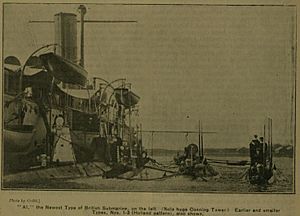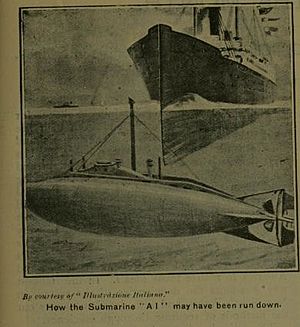HMS A1 facts for kids

HMS A1
|
|
Quick facts for kids History |
|
|---|---|
| Name | HMS A1 |
| Builder | Vickers, Barrow-in-Furness |
| Laid down | 19 February 1902 |
| Launched | 9 July 1902 |
| Fate | Lost, 1911. Wreck rediscovered 1989. |
| General characteristics | |
| Class and type | A-class submarine |
| Type | Submarine |
| Displacement |
|
| Length | 103.25 ft (31.47 m) |
| Beam | 11.9 ft (3.6 m) |
| Installed power |
|
| Propulsion |
|
| Speed |
|
| Range |
|
| Complement | 11 (2 officers and 9 ratings) |
| Armament | 2 × 18 in (450 mm) torpedo tubes (bow, four torpedoes) |
HMS A1 was the very first British-designed submarine for the Royal Navy. It was also the first British submarine where crew members sadly lost their lives.
This submarine was the first of a new type of British submarines called the A-class submarine class. It was also the only one in its class to have just one bow torpedo tube. HMS A1 actually sank twice! The first time was in 1904, and all the crew were lost. However, the submarine was brought back up and fixed. It sank again in 1911, but this time no one was on board. The wreck was found again in 1989 and was given special protection in 1998 under the Protection of Wrecks Act. Today, this important wreck is looked after by Historic England.
Contents
Building the A1 Submarine
HMS A1 was designed to be bigger and better than the Royal Navy's earlier "Holland"-type submarines. It was about 40 ft (12 m) longer. A big improvement was adding a conning tower, which is like a small tower on top for looking out. Later A-class submarines were even larger and had some differences from HMS A1.
Where it was Built
Like all submarines in its class, HMS A1 was built at Vickers in Barrow-in-Furness, a famous shipbuilding town. It was officially launched into the water on 9 July 1902.
Early Problems
Even before it left the shipyard, HMS A1 had some issues. There was an explosion caused by hydrogen gas. Later, while being pulled by another ship to Portsmouth, seawater got into its batteries. This caused chlorine gas to be released, and everyone had to leave the submarine quickly.
Accidents and Rediscovery
HMS A1 had a dramatic history, sinking twice and then being found years later.
First Sinking and Recovery
On 18 March 1904, HMS A1 accidentally sank in an area of water called The Solent. It was practicing an attack on another ship, the protected cruiser HMS Juno. A mail ship called SS Berwick Castle was on its way from Southampton to Hamburg and accidentally hit the submarine's conning tower.
The submarine sank in only 39 ft (12 m) of water. Sadly, the boat filled with water, and all the crew members drowned. Because of this accident, all future Royal Navy submarines were designed with a special watertight door at the bottom of the conning tower. This would help prevent flooding if something similar happened again.
About a month later, on 18 April 1904, HMS A1 was brought back up from the water. It was repaired and put back into service.
Second Sinking and Finding the Wreck
In August 1910, there was another accident involving a petrol explosion on board. After this, HMS A1 was changed to be a test submarine for the British Admiralty's Anti-Submarine Committee. This committee worked on ways to find and fight submarines.
A year later, in 1911, the submarine was lost again. It was running underwater by itself, using an automatic pilot, with no one on board. Even though people knew where it sank at the time, they couldn't find it.
It wasn't until 1989 that a local fisherman found the wreck of HMS A1. It was discovered near Bracklesham Bay, about 5 mi (8.0 km) from where it was thought to have sunk. Experts believe that when it sank the second time, it only partly filled with water. This meant it was still a bit floaty, and the strong currents in the area moved the wreck away from its original sinking spot.
The wreck of HMS A1 was given special protection under the Protection of Wrecks Act on 26 November 1998. The protected area around the wreck was made larger on 5 October 2004 to make sure it was fully safe.


